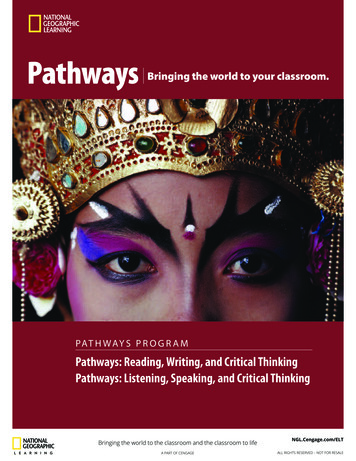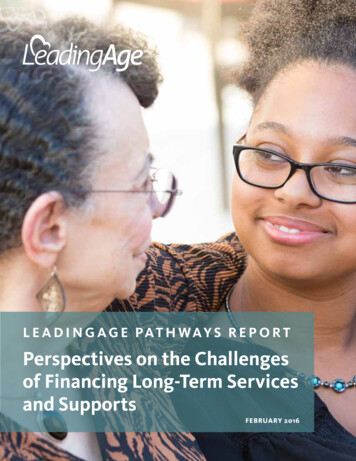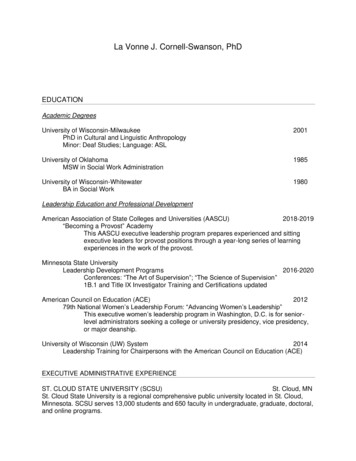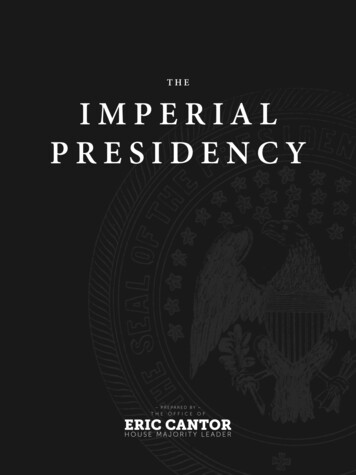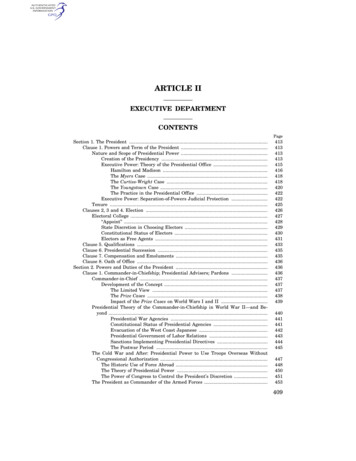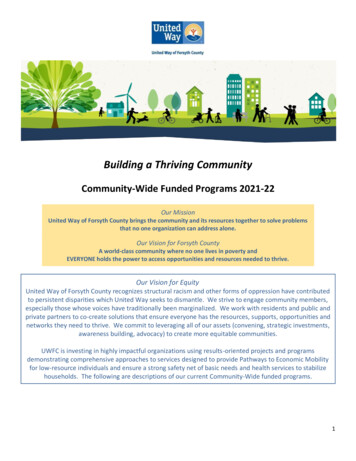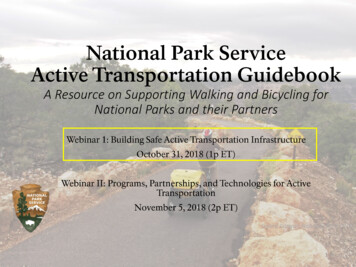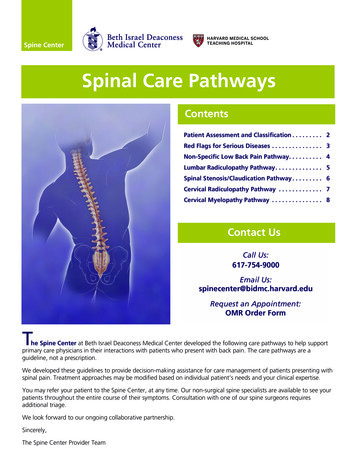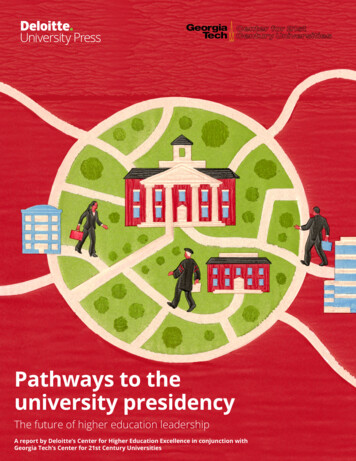
Transcription
Pathways to theuniversity presidencyThe future of higher education leadershipA report by Deloitte’s Center for Higher Education Excellence in conjunction withGeorgia Tech’s Center for 21st Century Universities
ABOUT DELOITTE’S CENTER FORHIGHER EDUCATION EXCELLENCEHigher education institutions confront a number of challenges, from dramatic shifts in sources of funding resulting from broader structural changes in the economy, to demands for greater accountabilityat all levels, to the imperative to increase effectiveness and efficiency through the adoption of moderntechnology.Deloitte’s Center for Higher Education Excellence produces groundbreaking research to help collegesand universities navigate these challenges and reimagine how they achieve excellence in every aspect ofthe academy: teaching, learning, and research. Through forums and immersive lab sessions, we engagethe higher education community collaboratively on a transformative journey, exploring critical topics,overcoming constraints, and expanding the limits of the art of the possible.ABOUT THE CENTER FOR 21ST CENTURYUNIVERSITIES AT GEORGIA TECHThe Center for 21st Century Universities (C21U) is Georgia Tech’s living laboratory for fundamentalchange in higher education. Disruptive innovations in higher education are evolving and Georgia Techis committed to leading the initiatives that will define the next generation of educational practices andtechnologies. As a research branch of the Office of the Provost, C21U works in tandem with campus administrators and faculty to identify, develop, and test new educational platforms and techniques.About Deloitte Consulting LLP's Organization Transformation & Talent practiceDigital and emerging technologies, changing market conditions, and regulatory pressures arecommon external forces that drive business transformation. Internally, new leadership and growthor consolidation strategies (including mergers and acquisitions) often spark transformation. Nomatter what the driver, the same challenges typically apply: how to align your organization design,talent, leadership, and culture with your business strategy to make the transformation vision areality, and then sustain it over time. Deloitte OT&T practitioners combine deep transformationexperience with practical business acumen. Our organization and people solutions incorporatean array of innovative tools and resources, powered by analytics, to enable sustainable change.Contact the authors for more information or read about Deloitte's Organization Transformation& Talent practice here: .html.COVER IMAGE BY: ALEX NABAUM
CONTENTSKey highlights 2Introduction 4The changing presidency 7President as chief fundraiser 11Preparing for the presidency 13Future challenges for campus leaders 16The next generation college presidency 20Endnotes 24
Pathways to the university presidencyKey highlightsTHE role of the college president has no analogin the modern business world.It is accountable to a dizzying array of stakeholders and constituents, on campus (students,faculty, and administrative staff) and off; parentswho are hyperinvolved in every aspect of their child’sexperience; community leaders seeking to influencethe university’s role in town; alumni who want tomaintain the experience they had as students; and,in the case of public institutions, political leaderswho demand greater accountability even in the faceof dwindling state support.The job requires administrative and financialacumen, fundraising ability, and political deftness.Presidents must be accessible and responsive butalso measured and restrained in an era driven by24/7 news coverage and the inflammatory nature ofsocial media. They often need to balance the pressures of society to improve the “return on investment” of education at their institution as well asmanage the pressure from community and politicalleaders around critical issues such as sexual assaultand legalized guns on campus. Presidents mustchart a difficult path with their academic deans,providing incentives for individual schools to exceland grow while fostering collaboration and cooperation with each other to drive the overall healthof the academy.The range of leadership skills with which theysurround themselves is vast—athletics, academics,finances, marketing, fundraising, and research toname just a few, all housed within a model of sharedgovernance that could drive almost any traditionalbusiness leader to distraction.In this look at the college president, we examinewhat it’s taken to be effective and excel in the roletoday, and how the dynamics of higher educationin America are driving a new set of skills and capabilities for tomorrow’s leaders. Deloitte’s Center for2
The future of higher education leadershipHigher Education Excellence, working in partnership with Georgia Tech’s Center for 21st CenturyUniversities, conducted this study through a combination of an extensive survey, in-depth interviews,and the first-ever analysis of presidential CVs.Among the highlights of our findings:preparing presidents to cultivate donors hasn’timproved much, if at all. A need for formal leadership development. Investments in leadership often lagbehind their importance to presidents. Whilenearly two-thirds of presidents surveyed saidthey had coaches or mentors to help themprepare for the role, only one-third indicatedthat they still receive coaching to succeed in thejob. Presidents identified leadership development as the second most important professionaltraining opportunity needed on the job (afterfundraising). Varied pathways. While the provost’s officehas long been the most frequent stopoverpoint on the way to the presidency, the pathsprospective presidents now take are becomingmore complex, fragmented, and overlapping.Academic deans are increasingly moving rightto the top job and bypassing the provost’s officealtogether. This is particularly the case at smallcolleges, where the institution as a whole is akinto the dean’s job at a large university. Emphasis on short-term wins at the costof long-term planning. There is increasingpressure on presidents to look for quick wins. Asa result, many are looking for the proverbial lowhanging fruit on their campuses where they canshow fast results, not only for their own boardsbut also for search committees for their next job. A new role for the provost. The provost is nolonger simply regarded as the No. 2 person oncampus. Rather, today’s provosts often have a setof skills that complement the president, ratherthan replicate them. The shift in responsibilitiesmeans that the provost’s role might not alwaysbe the best preparation for the presidency, especially if the provost is involved primarily withacademic affairs and internal issues.Even without the pressures bearing down rightnow on higher education, many college presidentsare likely in the final years of their tenure, giventhe demographics of those currently in the top job.A wave of departures is expected to come amongpresidents over the next few years. Where theirsuccessors will come from remains a key questionfor governing boards and other key stakeholders oncampuses. What follows is a primer to help leadersrecognize the challenges they may face and how topotentially rethink leadership for higher educationin the 21st century. President as fundraiser-in-chief. Fundraising is essential from a president’s first day inoffice, according to the survey, and only growsin importance over time in the position. But thatdoesn’t mean presidents are ready and willing totake on fundraising tasks. Despite the attentiongiven to this issue over the past several years,3
Pathways to the university presidencyIntroductionWly traveled far from the campus, and even pridedthemselves on knowing every student by name.HILE college presidents these days areoften compared to corporate CEOs, formuch of the early years of Americanhigher education they were often seen as little morethan an extension of the faculty. Most presidentswere clergymen who regularly taught classes, rare-At the turn of the 20th century, the college presidency started to take on an expanded role, asinstitutions increased their academic offerings.Out went the ministers as presidents and in cameTHE EVOLUTION OF THE COLLEGE PRESIDENCY1800sThe faculty memberCollege presidents are mostly clergy who split their time between running the institution andteaching. They are seen as the common man around campus, like Webster Merrifield at theUniversity of North Dakota, who often uses his own bank account as an interest-free studentloan fund.1900–1944The administratorAs colleges turn into more complex institutions, boards begin to search for managers to runthe campuses. As Rutherford B. Hayes, a member of the Ohio State University board, puts it,“we are looking for a man of business training, a man of affairs, and a great administrator.”5Presidents begin to see their role more as a profession and adopt an informal presidents’ clubamong their counterparts.1945–1975The builderAfter World War II and the passage of the GI Bill, a surge in student enrollment requirespresidents to build bigger and more formal administrative structures. An influx of new dollarsthrough federal science research and student aid allows presidents to expand both thephysical plant and academic offerings of their institutions to unprecedented levels.1976–2008The accountantFederal and state financing of higher education begins a slow shift from student grants toloans on the federal level and smaller direct appropriations on the state level. So presidentsbecome fiscal agents of their institutions, focusing much more on fundraising, buildingnew revenue streams, and searching for partnerships to share increasing costs.2009–presentThe multidisciplinarianHigher education faces a multitude of challenges —growing inequality among students andinstitutions, technology changing the world of learning and work, and fiscal constraints fromgovernments—requiring multidimensional leaders who can build and navigate academicdisciplines, institutions, and outside partnerships.Deloitte University Press dupress.deloitte.comSource: Deloitte analysis.4
The future of higher education leadershipmore professional administrators. When John H.Finley was announced as president of City Collegeof New York in 1903, he received a letter from theUniversity of Chicago’s president assuring him thatwhile “there are plenty of men to be professors;there are only a few to be presidents of colleges anduniversities.”11976, Kerr would describe presidents hired in the1950s, ’60s, and ’70s as “kind of out of date,” addingthe presidential type now needed was a “a kind ofsuper-accountant.”It was in these waning years of the 20th centurythat the college presidency began to turn into moreof a profession sought by academics who switchedjobs every few years and navigated through campusbureaucracies to better learn how to run complexinstitutions. Searches for presidents grew longerand more extensive and were managed by executive search firms that increasingly focused solely onhigher education.By the 1930s, a book about college presidentsdescribed the job as “the business manager of agreat plant, a lobbyist often at the general assemblyof the state and a peripatetic raiser of funds.”2 Thedecades after World War II—with the arrival of BabyBoomers to campuses and new federal spendingwith the onset of the Cold War—marked a newrole for presidents as dominant figures in highereducation’s expansion. Indeed, during this era twogiants of the college presidency rose to power—theUniversity of California’s Clark Kerr and the Rev.Theodore Hesburgh of Notre Dame.In 1986, the American Council on Education (ACE)published its first study of the college president. Itfound that campus leaders were mostly white malesin their early fifties.3 Four in ten presidents at thetime were in their forties, and most came to theposition through the provost’s office.The economic slowdown of the mid-1970s, and theresulting cuts in federal and state higher-educationspending, meant that college governing boardsstarted to look for leaders who could be betterfiscal managers and, increasingly, fundraisers. InIn subsequent surveys since then, ACE found thatlittle has changed about the people holding thetop job on campuses—except they are graying andnot staying in the role as long. Nearly six in tenMETHODOLOGYPlanning for this report began in the spring of 2016, as a joint project between Deloitte’s Center forHigher Education Excellence and Georgia Tech’s Center for 21st Century Universities.The initial phase included a literature scan of previous research on the state of the collegepresidency, in part to inform a survey of college presidents that was fielded in August 2016. Wewould like to thank the following individuals who provided their insight and expertise on the surveyquestions: Scott Cowen, Richard Ekman, Wes Moore, Carol Quillen, Shelly Weiss Storbeck, and DianaChapman Walsh.Surveys were sent via email to 1,031 presidents of four-year colleges and universities. Completedresponses were collected from 165 presidents, yielding a 16 percent response rate. Respondentsrepresented 112 private institutions and 51 public institutions.For the CV analysis, data was collected on 840 presidents, gleaned from publicly availableinformation on institutional websites and through other sources, such as LinkedIn. The followingstudents at the Georgia Institute of Technology assisted in the CV analysis: Rebecca Hull, Jing Li,Sarah Scott, and Lu Yin.Presidents and trustees—from a diverse representation by geography, institution type (public,private), campus type (single, multiple, online) and student body size—were interviewed by authorsand a note-taker from Deloitte between January and March 2017. All interview subjects were offeredanonymity to allow them to be frank in our conversations. Some waived the offer, but most of thequotes presented in the report from those interviews are without attribution to maintain consistency.5
Pathways to the university presidencypresidents are in their sixties and their averagetenure in the job is seven years, down from eightand a half years a decade ago.4in a state of change. As institutions look to hire thenext generation of leaders, what skill sets shouldthey be looking for? Where will presidents comefrom in the future? What training will they need tosucceed and thrive in the top job?A pipeline running dryThis report aims to answer those questions and morewith the results of a groundbreaking study on thefuture of the college presidency. In 2016, Deloitte’sCenter for Higher Education Excellence andGeorgia Tech’s Center for 21st Century Universitiesembarked on nearly a year of research that includeda survey of more than 150 current four-year collegeand university presidents, in-depth interviews withtwo dozen presidents and trustees, and data minedfrom more than 800 CVs of sitting presidents offour-year colleges to get a better sense of theircareer paths.What’s worrisome about these trends is that thetraditional pipeline to the job risks running dry inthe decade ahead, as the enormous demographicand financial challenges facing institutions intensify.Not only are presidents aging, but public flameoutsare ending their tenures early. Several presidentshave faced high-profile ousters in recent years.Where their successors will come from is more ofan open question among search committees thanever before. While the provost’s office remains themost common launching pad for presidencies, thereis evidence from surveys of sitting provosts thatmany no longer aspire to the top job, nor in someinstances have the broad set of skills necessary forthe changing demands of the role.Our hope is that this study informs planning fortrustees and college executives as they grapplewith the coming leadership changes and providesa roadmap for how higher education can betterprepare and select its next generation of presidents.Much like at the turn of the 20th century and thenagain in the 1970s, the college presidency today is6
The future of higher education leadershipThe changing presidencyAentrepreneurs on campuses with decentralizedbudgeting models. What’s more, they frequentlywork with advisory boards and are prodigiousfundraisers who oversee thousands of students.HUNDRED years ago, the college presidencywas described by academics as a “club” inwhich members had a similar pedigree andrecognized the problems each other was dealingwith on their campuses.The president of a small, liberal arts college toldus that the route from dean to president is a recognition that higher education’s often lengthyand sluggish climb to the top of the organizationdoesn’t work for a new generation of leaders.The modern college presidency lacks any sort ofcohesion.Our study found that fewer college leaders arriveat the top post in thesame way as in thepast or agree on theissues that face theircampuses. How presidents define their rolelargely depends onthe type of institution where they serve(research university vs.liberal arts college orpublic vs. private), howlong they’ve been inthe job, and the routethey took to get there.While the provost’soffice has long beenthe most frequentstopover point on theway to the presidency,the paths prospectivepresidents now takeare becoming morecomplex, fragmented,and overlapping.“Highly creative people need faster paths,or they are going togo elsewhere to findthem,” the presidentsaid. “It is difficult tospeed up the traditional route. We need tofind ways to promotepeople more quickly,and need quicker pathsto the presidency thanprovost.”Of the presidents inour CV analysis whonever served as a provost, two-thirds leadinstitutions with fewerthan 5,000 students(see figure 1). Thosewho went right from dean to president arenewer to the job than those who were provostsfirst, indicating that this pathway is likely a morerecent trend.While the provost’soffice has long been themost frequent stopoverpoint on the way to thepresidency, the pathsprospective presidentsnow take are becoming more complex, fragmented,and overlapping. Two primary developments seemto be responsible for these varied routes:1. Academic deans are increasingly moving right to the top job and bypassing theprovost’s office altogether. This is particularly the case at small colleges, where the institution as a whole is akin to the dean’s job at alarge university. Deans these days are essentially mini-presidents and are seen as academicThere is also a significant gender gap betweenthe traditional provost pathway and the fasttrack from dean (see figure 2). It’s much morecommon for women to stop at the provost’s officeon their way to the presidency. According to our7
Pathways to the university presidencyFigure 1. Presidents who did not serve as provosts work at smaller institutions62%43%46%23%17%16%14%14%12%8%8% 00 Number of students at institutionProvost to presidentDean to presidentDeloitte University Press dupress.deloitte.comFigure 2. Women more than men still come to the presidency from the provost roleWomenMenOverall82%18%57%43%64%36%Provost to presidentDean to presidentDeloitte University Press dupress.deloitte.comstudy, three times as many men as women wentright to the presidency from the dean’s office.tween the provost and the president,” a trusteeat a large public research university told us. Theprovost is focused “inward and down,” workingwith faculty and students on the academic experience. Meanwhile, the president is looking “upand out,” focused on relations with the governing board, the public, alumni, and in many cases,political leaders.2. The provost is no longer simply regardedas the No. 2 person on campus. Rather,today’s provosts often have a set of skills thatcomplement the president, rather than replicatethem. There is a “bit of separation occurring be-8
The future of higher education leadershipThis external focus is a critical role for a contemporary president to play in a day and age when socialmedia can turn a minor dustup into a national storyand impact an institution’s brand almost overnight.The “president owns the brand and the larger experience of ‘the university,’” the trustee said.Figure 3. The skills needed most whenpresidents assume officeRespondents were asked to rate “the importanceof the following knowledge skills and behaviorrequired to be a president when you assumedyour current role.” (n 165)The shift in responsibilities means that the provost’srole might not always be the best preparation forthe presidency, especially if the provost is involvedprimarily with academic affairs and internal issues.In our survey, presidents told us that being an“academic and intellectual leader” ranked last amonga set of skills and behaviors most needed when theyassumed office. At the top of the list: strategist,communicator, and storyteller (see figure 3).#1: Strategist#2: Communicator andstoryteller#3: Fundraiser“Universities have big goals and big aspirations, butcan be very linear places with very incremental strategic plans,” said the president of a large, publicland-grant university. “They need nonlinear planning and a strategy mind-set to reach big goals.”#4: CollaboratorThe way presidents view the skills required for thejob differs depending on how long they’ve been inthe role.#5: Financial andoperational acumen#6: Academic andintellectual leaderIn general, veteran presidents surveyed tend tothink of higher education as a collegial, intellectual community where they are the academicleader. New presidents, meanwhile, see themselvesthrough a financial and operational lens and asa leader who needs to get things done despite thecollaborative nature of campuses—a CEO role, notin the top-down sense, but rather a general managersurrounded by a skilled executive team.Deloitte University Press dupress.deloitte.comwill fill their offices in the future. Presidents in thejob for more than 15 years value academic and intellectual skills and consider the provost as their likelysuccessor; presidents with less than a decade ofexperience say financial and operational acumenis most important and say the person next in linefor the role will most likely come from the privatesector (see figure 4).These often opposing opinions of the campus leadership role influence the competencies presidentsthink are required for the job and who they believe9
Pathways to the university presidencyFigure 4. How long presidents have been in office shapes their view of the role 15 years in office10–15 years in office 10 years in officePerceived importance of skills when respondents assumed their current roleNotimportantNeutralVeryimportantAcademic andintellectual leaderCollaboratorFinancial andoperational acumenPerceived likelihood of finding successor across talent sourcesNot likelyNeutralLikelyProvost/Chief academic officerAcademic dean/Department chairPublic sector/GovernmentPrivate sector/BusinessDeloitte University Press dupress.deloitte.comBEST PREP FOR THE PRESIDENCY? TAKE ON A RANGE OF EXTRA WORKDuring our interviews, we asked presidents about the advice they would give to others seeking therole. Here’s what an experienced president of a large urban public research university told us: Seek breadth and depth. Get the broad experiences to understand how universities work.“Amazing what you can learn doing things nobody else wants to do,” the president said. Look outward. Gain experience working with external partners and relationship building. “Aspresident, you’re the external person, not internal.” Acquire budget experience. Money is the critical tool to realizing any plan as president.Here are three ways this campus chief told us that great leaders differ from the good ones: Pay attention to the culture and process. “They matter a lot. If you get the process right, youcan do anything.” Be a planner. “Remember, you’re always playing chess. Must always be thinking three movesahead.” Don’t move from one press release to another. “That means you are reactionary. Publicitywill follow if you’re being strategic.” Have a goal and a pathway to get there. “If you don't know where you're going, you'll end upsomewhere.”10
The future of higher education leadershipPresident as chief fundraiserWHERE there is agreement among presidents—no matter the size of the institution or their tenure in the position—is onthe outsized role fundraising plays in their job andhow many of them still feel unprepared for it. ClarkKerr first recognized the need for the president to bechief fundraiser in the 1970s, when state and federalsupport for higher education began to wane.6 Thetrends Kerr identified have only accelerated sincethen, and, in many ways, have been made worse bythe flatlining of wages in the United States that havemade it difficult for even middle-class families to afford rising tuition prices.Fundraising, in particular,is essential from apresident’s first day inoffice. and only growsin importance overtime in the position.survey, and only grows in importance over time inthe position.Presidents told us in our survey that “fundraising/alumni relations/donor relations” and “strategicplanning” rank as the most important responsibilities in their day-to-day job (see figure 5).Fundraising, in particular, is essential from apresident’s first day in office, according to theBut that doesn’t mean presidents are ready andwilling to take on fundraising tasks. Past surveysof presidents dating back more than a decadehave diagnosed the gap between the importance offundraising in the top job and the lack of trainingFigure 5. Most important responsibilities of presidents, according to respondentsFederal and stategovernment relations2% Student life/student engagement1% AthleticsCommunity/civic relationsAcademic i/donor relations5%5% 4%12%15%%that fundraising/alumni/donor relations65% believeranks among the top three most important20%andresponsibilities in their current rolethat fundraising has increased in50% believeimportance since they assumed their roleof totalresponses20%16%Strategic planning (goal-setting, visioning)Enrollment managementDeloitte University Press dupress.deloitte.com11
Pathways to the university presidencyfor it. The results of our survey show that despitethe attention given to this issue over the past severalyears, preparing presidents to cultivate donorshasn’t improved much, if at all.of fundraising. When asked in the survey to gaugetheir preparedness to provide oversight on a rangeof campus issues, presidents ranked fundraisingand alumni/donor relations sixth out of ten—belowstrategic planning, community relations, andbudgeting. No wonder presidents said fundraisingwas the most important skill needed for theirprofessional development (see figure 6).Indeed, in our survey a wide gap existed betweenthe perceived importance of fundraising to apresident’s professional development and theability of the campus executive to provide oversightFigure 6. Presidents need the most help on fundraising. and feel ill-prepared to provideoversight to others on developmentRespondents were asked to “rate the level of importance for each of the following categories of professionaldevelopment for your role as president.” 1 Not important; 5 Very important. (n mic affairs3.763.61Legal issues facing higher educationStudent affairs3.412.76ResearchRespondents were asked to “indicate your level of preparedness to provide executive oversight of thefollowing areas.” 1 Less prepared; 5 More prepared. (n 165)4.40Strategic planning (goal-setting, visioning)4.33Academic affairsCommunity/civic onor relations3.88Trustee relations3.67Enrollment management3.58Student life/student engagement3.52Federal and state government relations3.39AthleticsDeloitte University Press dupress.deloitte.com12
The future of higher education leadershipPreparing for the presidencyUNLIKE chief executives of Fortune 500 companies who tend to go to business schooland are groomed by organizations for thetop role, historically being a college president hasinvolved mostly on-the-job training. When institutions were smaller and less complex, presidentscould easily move up from the faculty to lead thecampus with little instruction. But today’s challenging higher-education environment requires leaderswho are adept at navigating various stakeholdergroups through a period of rapid change.While nearly two-thirds ofpresidents in the surveysaid they had coachesor mentors to help themprepare for the role, onlyone-third indicated thatthey still receive coachingto succeed in the job.Even so, no formal training regimen exists to prepare for the presidency. Our survey found that investments in leadership often lag behind their importance to presidents. While nearly two-thirds ofpresidents in the survey said they had coaches ormentors to help them prepare for the role, onlyone-third indicated that they still receive coachingto succeed in the job.Presidents surveyed identified leadership development as the second most important professionaltraining opportunity needed on the job (after fundraising). “Leadership development is stigmatized inhigher education,” the president of a public university told us. “There is knowledge out there that canhelp people become better leaders, but it’s vilifiedamong faculty members who don’t understand it.”Compare the attitudes toward leadership development in higher education to the corporate world,where, in a survey of 10,000 HR and business leaders by Deloitte, 78 percent identified leadership development as the top issue for companies aroundthe world. Some 84 percent of global organizationsoffer f
the campuses. As Rutherford B. Hayes, a member of the Ohio State University board, puts it, "we are looking for a man of business training, a man of affairs, and a great administrator."5 Presidents begin to see their role more as a profession and adopt an informal presidents' club among their counterparts. 1945-1975 The builder



